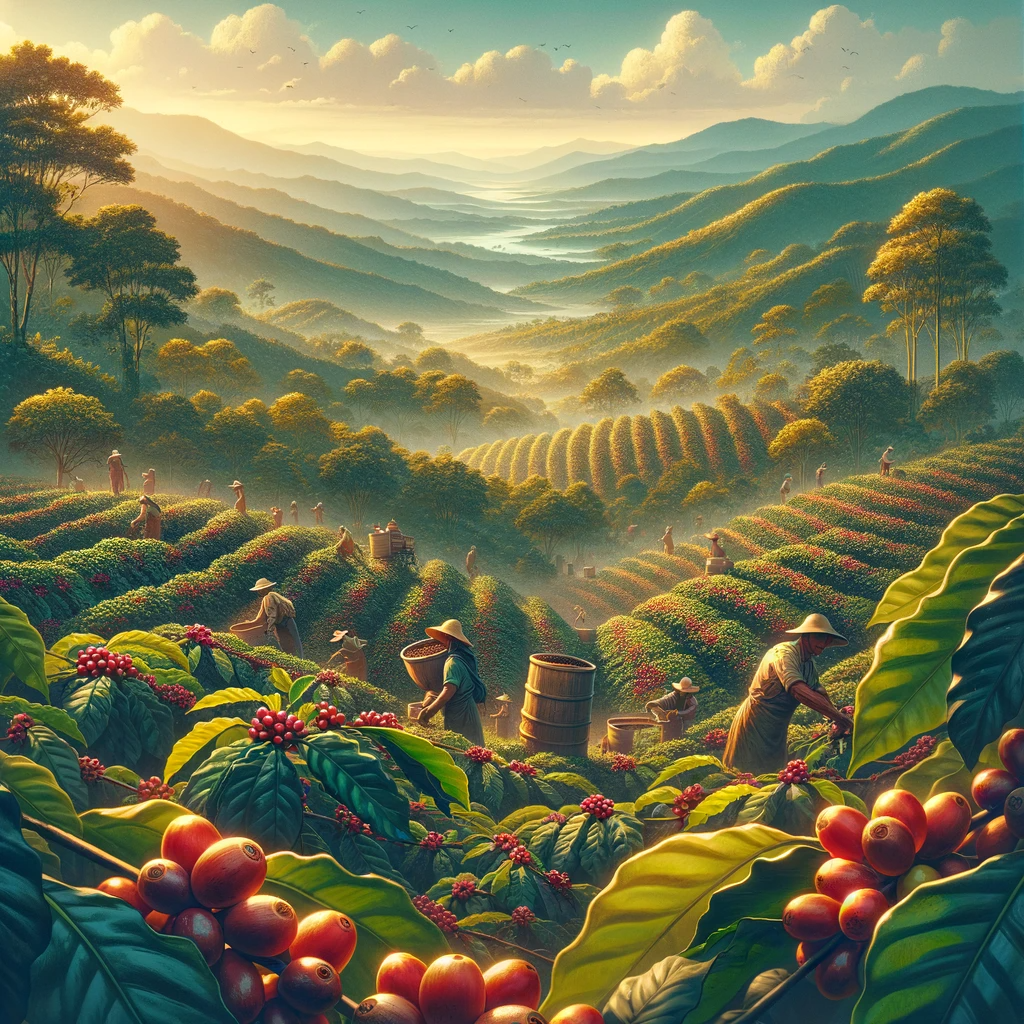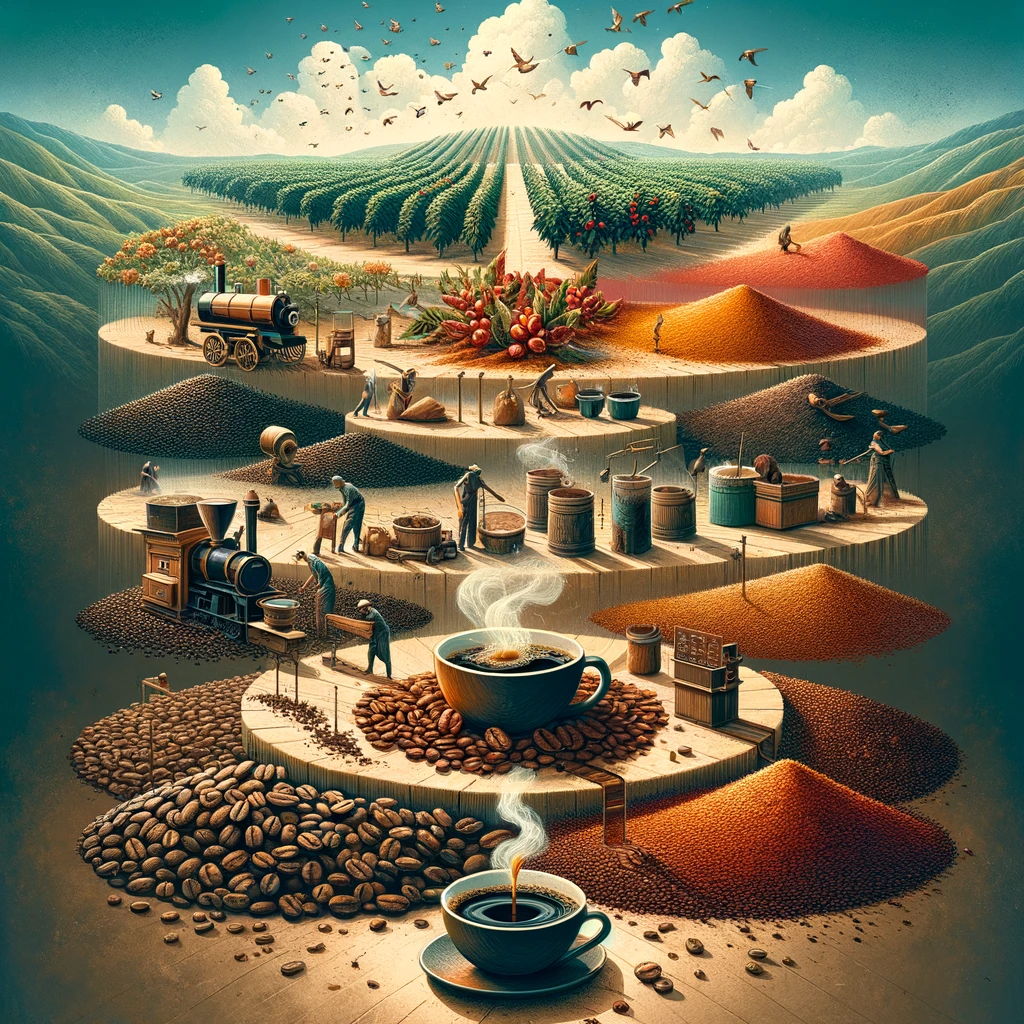Introduction
Coffee is a beloved beverage consumed by millions around the world, but have you ever wondered where those magical beans come from? The geographic origin of coffee plays a significant role in its flavor profile and quality. Coffee production is a complex process that starts with the cultivation of coffee plants and ends with the roasting of the beans. Understanding the origins of coffee beans allows us to appreciate the diversity and uniqueness of different coffee varieties. From the birthplace of coffee in Ethiopia to the vast coffee plantations of Brazil, this article will take you on a journey tracing the geographic origins of coffee beans. Join us as we discover the rich history and flavors behind this refreshing beverage.
Overview Of The Importance And Popularity Of Coffee
Coffee holds immense importance and enjoys unparalleled popularity around the globe. As one of the three most consumed beverages worldwide, coffee has become an integral part of many people’s daily lives. Its stimulating effects and rich flavors make it a beloved drink for millions. Aside from its stimulating properties, coffee also offers various health benefits, such as boosting cognitive function and enhancing mood. Additionally, the coffee industry plays a significant role in the global economy, providing employment and income for millions of people involved in cultivation, processing, and distribution. Coffee’s widespread popularity and cultural significance highlight its incredible impact on society and its standing as a beloved beverage worldwide.
Overview Of The Coffee Bean Production Process
The coffee bean production process is a complex and intricate journey that begins with the cultivation of coffee plants. Coffee beans are primarily grown in tropical regions around the world, where the climate and soil conditions are ideal for their growth. Farmers carefully nurture the plants, ensuring proper irrigation, maintenance, and protection against pests and diseases.
Once the coffee cherries are ripe, they are harvested by hand or using machinery. The cherries are then processed to remove the outer fruit and expose the coffee beans inside. There are two main methods of processing: the dry method, which involves sun-drying the cherries, and the wet method, which involves fermentation and washing.
After processing, the coffee beans are typically sorted and graded based on their size, shape, and quality. They are then roasted to enhance their flavors and aromas. Finally, the roasted beans are ground and brewed to create the beloved beverage we all know as coffee.
The coffee bean production process requires great attention to detail and expertise to ensure the highest quality beans are produced. From cultivation to processing to roasting, each step plays a crucial role in shaping the final taste and characteristics of the coffee.
Major Coffee Bean Growing Regions
The coffee bean industry thrives in several major growing regions around the world. Each region has its unique characteristics that contribute to the flavors and qualities of the coffee beans produced there.
One of the most prominent coffee bean-growing regions in Latin America, which is considered the birthplace of Arabica coffee. Countries like Colombia and Brazil are renowned for their high-quality Arabica beans. Colombia, in particular, is known for its rich and balanced coffee flavors.
Africa is another significant coffee bean-growing region, with Ethiopia being the birthplace of coffee itself. Ethiopian coffee is famous for its vibrant and fruity flavors. Kenya, on the other hand, produces distinctive and flavorful Arabica beans.
Other notable coffee bean origins include Asia, where unique coffee cultivars are grown, and Central America, which is known for producing fine Arabica and Robusta beans.
These major coffee bean-growing regions play a crucial role in determining the taste and characteristics of the coffee we enjoy. Exploring the different origins allows coffee enthusiasts to appreciate the diverse flavors and profiles that coffee has to offer.
Latin America: Birthplace Of Arabica Coffee
Latin America is known as the birthplace of Arabica coffee, one of the most popular and sought-after coffee varieties in the world. Countries like Colombia and Brazil have gained international acclaim for their high-quality Arabica beans. Colombia, in particular, is revered for its rich and balanced coffee flavors. The favorable climate and altitude in this region make it ideal for growing Arabica coffee, allowing the beans to develop their distinct taste profiles. Additionally, Brazil stands as the world’s largest coffee producer, producing a significant portion of the global coffee supply. These Latin American countries have played a crucial role in shaping the coffee industry and continue to provide coffee lovers with exceptional Arabica coffee beans.
Africa: Home To Diverse Coffee Varieties
Africa is known as a hub of diverse coffee varieties, with each region offering its unique flavors and profiles. From the birthplace of coffee in Ethiopia to the high-quality Arabica beans of Kenya, the continent boasts a wide range of coffee options for enthusiasts to explore. Ethiopia, in particular, is hailed as the birthplace of coffee and is famous for its rich and fruity flavors. Kenya, on the other hand, is renowned for its distinctive and flavorful Arabica beans, which are known for their bright acidity and floral notes. Other countries in Africa, such as Uganda and Tanzania, also produce excellent coffee with their distinct characteristics. Exploring the coffee origins of Africa is a delightful journey of discovery for coffee lovers seeking new and exciting flavors.
Latin American Coffee Bean Origins
Latin America is considered the birthplace of Arabica coffee, one of the most widely consumed and highly regarded coffee varieties in the world. Colombia stands out as a prominent producer of high-quality Arabica beans, known for their distinct flavors and aromas. The country’s unique geography, with its mountainous landscape and tropical climate, provides ideal conditions for coffee cultivation. Brazil, on the other hand, holds the distinction of being the largest coffee producer globally, accounting for a significant portion of the world’s coffee supply. Brazilian coffee is known for its smooth and nutty flavors, making it a popular choice for espresso blends. These Latin American countries have made a substantial impact on the coffee industry, contributing to the diverse and rich flavors enjoyed by coffee enthusiasts worldwide.
Colombia: Renowned For Its High-quality Arabica Beans
Colombia, situated in the northwest of South America, is renowned for producing high-quality Arabica coffee beans. The country’s unique geographical location, combined with its rich volcanic soil and ideal climate, creates optimal conditions for coffee cultivation. Nestled in the Coffee Triangle, a region in the Paisa region on the western side of the Andes Mountains, Colombia’s coffee plantations thrive. The traditional farming methods employed by Colombian coffee growers contribute to the exceptional flavor profiles of their Arabica beans. Colombian coffee is known for its well-balanced acidity, bright flavors, and distinct aromas, making it highly sought after by coffee connoisseurs. With its reputation for producing some of the world’s finest Arabica beans, Colombia continues to be a prominent player in the global coffee industry.
Brazil: The World’s Largest Coffee Producer
Brazil has established itself as the world’s largest coffee producer, accounting for about a third of global coffee production. With coffee plantations sprawling across approximately 27,000 square kilometers, Brazil has the perfect climate and conditions for cultivating coffee beans. The country’s coffee industry experienced significant growth in the 19th century, and by the 1830s, coffee had become Brazil’s largest export, making up 30% of the world’s coffee production. The industry continued to flourish, and by the 1840s, Brazil’s share of total exports and global production had reached a staggering 40%. Brazil’s dominance in the coffee market can be attributed to its vast plantations, favorable climate, and historical reliance on coffee as a major export commodity.
African Coffee Bean Origins
Africa is known as the birthplace of coffee, and it continues to be a significant region for coffee production. Ethiopia, in particular, holds a special place in the history of coffee. It is believed that coffee cultivation began in Ethiopia as early as the 9th century. Ethiopian coffee is known for its unique and distinct flavors, with each region producing its distinct taste profiles. Kenya is another African country that is renowned for its coffee production. Kenyan Arabica beans are celebrated for their exceptional quality and complexity of flavors. African coffee beans, with their rich and diverse flavors, play a crucial role in the global coffee industry and are highly appreciated by coffee connoisseurs around the world.
Ethiopia: The Birthplace Of Coffee
Ethiopia holds a significant place in the history of coffee as it is believed to be the birthplace of this beloved beverage. Dating back centuries, the ancient coffee forests on the Ethiopian plateau were where coffee cultivation first began. According to legend, a goat herder named Kaldi discovered the potential of coffee beans when he noticed his goats becoming energetic after eating the berries. This discovery eventually led to the spread of coffee cultivation and consumption worldwide. Ethiopian coffee is known for its unique and distinct flavors, with each region producing its distinct taste profiles. Today, Ethiopian coffee continues to be highly regarded and cherished for its rich heritage and exceptional quality.
Kenya: Known For Its Distinctive And Flavorful Arabica Beans
Kenya is renowned in the coffee world for its distinctive and flavorful Arabica beans. The country’s unique geographic location, which includes high altitudes and rich volcanic soil, creates the perfect conditions for coffee cultivation. Kenyan coffee is known for its bright acidity, complex flavors, and full-bodied taste. The coffee beans are hand-picked by skilled farmers and carefully processed to ensure their exceptional quality. Kenyan coffee is often characterized by its vibrant and fruity notes, with flavors ranging from blackcurrant and citrus to winey and floral undertones. This distinct flavor profile has made Kenya a favorite among coffee connoisseurs and has earned it a reputation as one of the top coffee-producing countries in the world.
Other Significant Coffee Bean Origins
Asia is another significant coffee bean origin known for its unique coffee cultivars. Countries like Indonesia, Vietnam, and India have made their mark in the coffee industry. Indonesia, particularly Sumatra, is famed for its rich and earthy flavors, often exhibiting notes of spice and chocolate. Vietnam, on the other hand, is a major producer of robusta beans, known for their strong and bold taste. India is known for its unique monsooned coffee, a process in which the beans are exposed to the monsoon winds, leading to a distinct flavor profile. Additionally, Central American countries like Costa Rica and Guatemala produce fine arabica and robusta beans, adding to the variety of coffee origins available in the market. With each origin offering its own distinct flavors, exploring the diverse coffee bean origins can be an exciting journey for coffee enthusiasts.
Asia: Notable For Unique Coffee Cultivars
Asia is a significant coffee bean origin known for its unique coffee cultivars. Apart from Indonesia, Vietnam, and India, several other countries in Asia are notable for their coffee production. Thailand, for example, has gained recognition for its specialty coffee varieties, such as Doi Chaang and Doi Tung. Myanmar, also known as Burma, has been making a mark in the specialty coffee industry with its high-quality Arabica beans grown in the Shan State. Nepal, Laos, and even Yunnan province in China have also been making strides in coffee cultivation, showcasing their own distinct flavor profiles. These lesser-known coffee origins in Asia provide coffee enthusiasts with a diverse range of flavors to explore.
Central America: Producing Fine Arabica And Robusta Beans
Central America is a significant region when it comes to coffee production, known for its fine Arabica and Robusta beans. Countries such as Costa Rica, Guatemala, Nicaragua, El Salvador, and Honduras are major contributors to the coffee industry in this region. The favorable climate, high altitude, and volcanic soil of Central America provide optimal conditions for growing high-quality coffee beans. Arabica beans from this region are celebrated for their delicate flavors and distinct profiles, ranging from fruity and floral to chocolatey and nutty. On the other hand, Central America also produces Robusta beans, which have a stronger, more robust taste and are often used in blends and espresso production. The coffee beans from Central America continue to captivate coffee enthusiasts worldwide with their exceptional taste and quality.
Conclusion
In conclusion, the geographic origins of coffee beans play a significant role in determining their flavor profiles and characteristics. The unique climates, altitudes, and soil compositions of different regions contribute to the distinct taste and quality of coffee from each origin. From Latin America, where Arabica beans thrive and produce delicate flavors, to Africa, home to diverse coffee varieties, each region offers a unique coffee experience. Additionally, countries such as Ethiopia and Colombia have established themselves as renowned coffee producers known for their exceptional Arabica beans. Exploring the origins of coffee allows coffee enthusiasts to appreciate the rich diversity and complexity of this beloved beverage. So, the next time you enjoy a cup of coffee, take a moment to ponder the journey and origins of those flavorful beans.
The Impact Of Geography On Coffee Bean Flavor Profiles
The geographic origin of coffee beans plays a significant role in shaping their flavor profiles. The unique climates, altitudes, and soil compositions of different regions influence the taste and characteristics of the coffee grown there. For example, Latin American countries such as Colombia are renowned for producing high-quality Arabica beans with delicate flavors and acidity. In contrast, African countries like Ethiopia are known for their diverse coffee varieties, offering a range of complex and fruity flavors. Additionally, factors like rainfall patterns and sunlight exposure in different regions further contribute to the unique flavor profiles of coffee beans. Understanding and appreciating the impact of geography on coffee bean flavors allows coffee enthusiasts to explore the richness and diversity of this beloved beverage.
Appreciation And Exploration Of Different Coffee Origins
Coffee enthusiasts appreciate the diverse origins of coffee beans for the unique flavors and characteristics they offer. Exploring different coffee origins allows individuals to understand the impact of geography on flavor profiles and broaden their palate. From the delicate and acidic Arabica beans of Colombia to the diverse and fruity varieties of Ethiopia, each origin presents a distinct taste experience. By delving into the flavors of coffee from different regions, such as Latin America, Africa, Asia, and Central America, coffee lovers can appreciate the nuances and complexities that arise from different growing conditions and processing methods. This exploration fosters a deeper appreciation for the rich world of coffee and enhances the enjoyment of this beloved beverage.
Frequently Asked Questions about Coffee Beans Origin
Q: Where do coffee beans come from?
A: Coffee beans come from the seeds found inside the fruits of the coffee plant. These plants are primarily grown in regions located along the equator, known as the “coffee belt” or the “bean belt.” This area spans the globe between the Tropics of Cancer and Capricorn, encompassing countries in South and Central America, Africa, and Southeast Asia.
Q: How did coffee cultivation originate?
A: The origins of coffee cultivation can be traced back centuries ago to Ethiopia in East Africa. Legend has it that a goat herder discovered the energizing effects of coffee after observing his goats becoming more lively after consuming the plant’s cherries. Over time, knowledge about coffee spread across different regions, leading to its cultivation and the development of various brewing traditions.
Q: Which countries are major producers of coffee beans?
A: Several countries around the world are major producers of coffee beans. Brazil takes the lead as the largest producer, followed by Vietnam, Colombia, Indonesia, and Ethiopia. Other significant coffee-producing nations include Honduras, Peru, Mexico, Uganda, and India. Each country produces coffee with unique flavors and characteristics due to diverse climates, altitudes, and processing methods.
Q: What are the different types of coffee beans?
A: Two main types of coffee beans dominate the industry: Arabica and Robusta. Arabica beans are often considered higher quality and more flavorful, accounting for about 60% of the world’s coffee production. They are known for their delicate taste, complex flavors, and aromatic profiles. On the other hand, Robusta beans are hardier, with a higher caffeine content and a stronger, more bitter taste.
Q: How are coffee beans harvested and processed?
A: The methods of harvesting and processing coffee beans can differ depending on the region and the desired flavor profile. There are two primary techniques: the “dry” (natural) process and the “wet” (washed) process. In the dry process, the cherries are left to dry naturally, enabling the fruit to shrivel and expose the beans. The wet process involves pulping the cherries to extract the beans and then fermenting and washing them to remove the remaining pulp.
Q: Do coffee beans have specific flavor profiles based on their origin?
A: Yes, the origin of coffee beans plays a significant role in determining their flavor profiles. The soil, climate, altitude, and processing methods all contribute to the unique characteristics of coffee from different regions. For example, coffees from Ethiopia often exhibit fruity and floral notes, while those from Colombia may have a brighter acidity and hints of nuttiness. Exploring different origins allows coffee enthusiasts to discover a wide range of flavors.
Q: Is coffee production sustainable?
A: Sustainable coffee production is a growing concern among consumers and producers alike. Many coffee-growing regions face environmental challenges, such as deforestation, soil erosion, and water pollution. To address these issues, various certifications and initiatives promote sustainable farming practices. Fairtrade, Rainforest Alliance, and Organic certifications ensure that coffee is produced in environmentally friendly ways while providing fair wages and better working conditions for farmers.
Q: How important is coffee to the economies of coffee-producing countries?
A: Coffee production plays a vital role in the economies of many countries. In some regions, it is a significant source of employment and income for thousands of small-scale farmers. Coffee exports contribute to the GDP of countries such as Brazil, Vietnam, and Colombia. The coffee industry also supports an extensive supply chain, including processing, roasting, packaging, and retail, creating employment opportunities globally.

Hey there! If you’re in need of a catchy social media description for the content by Steven Benton, the owner at Easy Mug Coffee, then look no further. Here’s a suggestion: “Welcome to the ultimate coffee haven! Join Steven Benton, the mastermind behind Easy Mug Coffee, as he takes you on a delightful journey through the world of coffee. This blog is a paradise for all coffee lovers out there, so get ready to brew, sip, and savor every moment with us!” Let me know if there’s anything else I can help you with!



